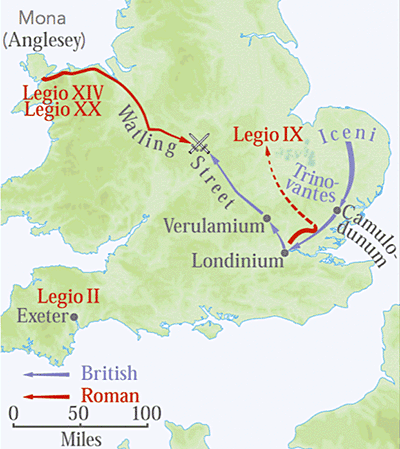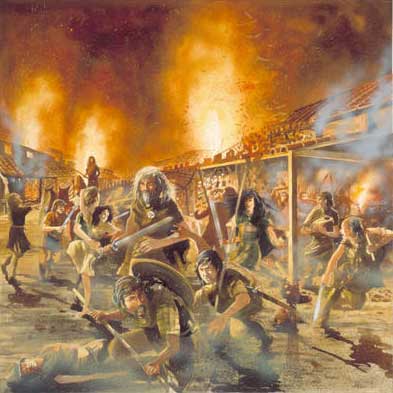The Advance To and Fall of Colchester
The Advance To and Fall of Colchester | London falls
Verulamium is taken | The final battle
Events after the rebellion
The advance to Colchester
 In the
south, the Trinovantes were also at odds with the Romans over the way in which Camulodunum (Colchester) had
been commandeered as a retirement home for Roman veterans. The Trinovantes too, displayed
acts of defiance, though on a smaller scale.
In the
south, the Trinovantes were also at odds with the Romans over the way in which Camulodunum (Colchester) had
been commandeered as a retirement home for Roman veterans. The Trinovantes too, displayed
acts of defiance, though on a smaller scale.
Boudicca gathered her forces together, both Iceni and Trinovante stood shoulder to shoulder. The march was believed to have started from the Iceni capital of Venta, (Caistor St. Edmund) which is a few miles south east of present day Norwich.
They began heading south, towards Camulodunum, slaughtering anyone who stood in their way — anything or anybody that was remotely connected with the Romans, was killed or destroyed.
Paulinus received the news of the uprising, and immediately despatched forces to intercept and quell the rebellion. This would take time, as the rebels were approaching Camulodunum, which was not heavily defended due to the number of troops that had been removed to fight in Wales.
Tacitus:
Meanwhile, without any evident cause, the statue of Victory at Camulodunum fell prostrate and turned its back to the enemy, as though it fled before them. Women excited to frenzy prophesied impending destruction; raving in a strange tongue, it was said, were heard in their Senate-house; their theatre resounded with wailings, and in the estuary of the Tamesa had been seen the appearance of an overthrown town; even the ocean had worn the aspect of blood, and, when the tide ebbed, there had been left the likenesses of human forms, marvels interpreted by the Britons, as hopeful, by the veterans, as alarming.
 Colchester had many fine buildings. Council chambers, theatre,
and a temple of the Imperial Cult. This temple became a particular target for the
Britons as it represented everything that they hated about the Romans.
Colchester had many fine buildings. Council chambers, theatre,
and a temple of the Imperial Cult. This temple became a particular target for the
Britons as it represented everything that they hated about the Romans.
The Imperial Cult was set up for the purpose of encouraging influential tribe leaders to show loyalty to the Emperor and in return being allowed to enter the Roman governing class. In fact the exact opposite seems to have happened, with many members of the cult being involved in the rebellion. There were only a handful of regular troops in the area and they soon fell to the onslaught. Those that survived took refuge in the temple, where they held out for two days before being overwhelmed and killed..
By now the Iceni and Trinovantes numbered about 100,000, far more than the soldiers remaining in the area to fight them
The Romans send forces
Seeing the massed tribal forces descending on Camulodunum, the Romans sent a messenger to Londinium (London) to request Procurator Decianus to send troops to aid the besieged Roman veterans.
Legio IX Hispana, led by Petilius Cerialis, was ordered to Camulodunum from their base, in Lindum Colonia (Lincoln). From Lindum, it was a distance of at least 110 miles. Cerialis wasted no time and immediately sent his troops in to deal with the rebels. They may have taken the Roman road to Camulodunum from Durovigtum (Godmanchester, Cambridgeshire), a march of some 75 miles which would have taken three days.
Tt the Battle of Camulodunum, Legio IX, when most of the foot-soldiers were killed in a disastrous attempt to relieve the besieged city of (Colchester). Only the cavalry escaped. The legion was later reinforced with legionaries from the Germania provinces.
Legio IX attempted to relieve the siege Camulodunum It's unlikely that the entire legionary strength of some 5,000 men was involved in the battle. Detachments of the legion were spread out across a network of small forts; on short notice, Cerialis was likely able to call on only the first cohort, possibly two others, auxiliary infantry, and a unit of some 500 cavalry — a total of perhaps 2,500 men.
However, Legio IX arrived too late to relieve the colonia. The British tribes had gathered a considerable force by the time Cerialis and Legio IX approached Camulodunum. Boudicca had already received news of their arrival. The British warriors ambushed the legion just north of Camulodunum, overwhelming the detachment in the field and defeating it, routing the Romans. Tacitus says their entire infantry strength was wiped out, with only Cerialis and his cavalry able to retreat to their fortified camp. According to George Patrick Welch, "In the initial contact and later rear-guard actions he lost about 2,000 men, or one-third of his infantry strength." Only the cavalry survived in any numbers and Cerialis ordered them to retreat north, while the rebels marched onward to Londinium.
The Advance To and Fall of Colchester | London falls
Verulamium is taken | The final battle
Events after the rebellion




















